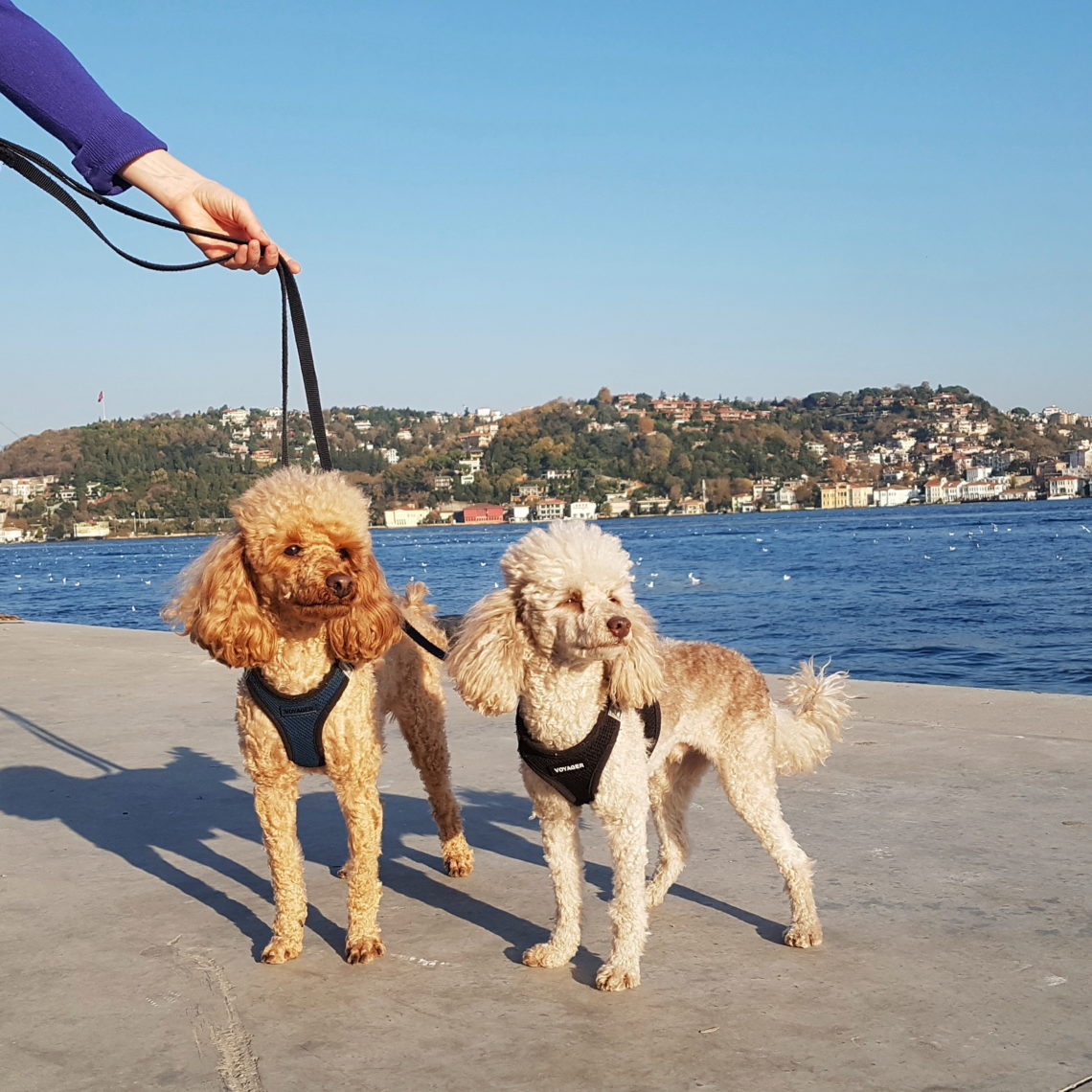
Long-Term Travel With A Dog
What We’ve Learned About How To Travel With A Dog
It’s been six months since we first bundled our dogs into their carriers, hopped on a one-way flight from Singapore to Poland and began our life of full-time travel. Although we had enjoyed many vacations around the world in the previous years, this time it was different. Not only was our journey planned to be indefinite, we also had two little furry passengers along for the ride.
In the past six months, we’ve learned that traveling with our dogs is a lot more complicated and usually a bit more expensive. However, once we learned a few basic lessons and established a good travel routine, we found that it’s well worth the extra effort to bring them along.
By way of background, we had been living in Singapore as expats for the past several years when we agreed that we wanted a change of lifestyle. We came up with a vision for our future that would see us step away from our corporate jobs — in other words, retire early — and spend the next few years traveling. The only real challenge to our plan was that we had two dogs that, of course, we didn’t want to leave behind. As we researched our options, we discovered other people — bloggers and vloggers — who were traveling long term with their dogs all over the world. This opened our eyes to the possibilities.
We also discovered that our dogs were the right size to come into the plane cabin with us, which made the whole proposition much more feasible. Once we knew the logistics would work, we decided to start our adventure in Europe because it’s such a dog-friendly region.
Again, we wanted to reiterate that traveling with a dog makes everything a little more complicated. But we’ve learned a few things along the way that will hopefully be helpful to you when planning your adventure.
Our Freedom Years is a participant in the Amazon Services LLC Associates Program, an affiliate advertising program designed to provide a means for sites to earn advertising fees by advertising and linking to amazon.com.

Design Your Freedom
FREE 7-Day Course
Financial independence and early retirement are achievable.
Click here to sign up
Pace of travel
When we were just two humans traveling to new countries, we would try to have as many experiences as possible and get to a new destination every couple of days. However, we’ve found that it’s difficult to travel that quickly with a dog. They are very sensitive to changes in their surroundings and need lots of structure and routine to feel comfortable.
We recommend slow travel where you spend a longer period in a place. Slow travel can be defined as whatever works for you and your dog. It could be a couple weeks or it could be a couple months. Whatever pace you choose, be sure to allow enough time in each place to allow your dog to settle into a new routine and new neighbourhood.
Travel essentials
What you bring along for your dog will depend on the needs of your dog and also the mode of transportation. Here are the items that we consider essential for our dogs (these are affiliate links):
For travel days…
- Soft-sided carriers that fit within airline specifications
- A collapsible water bowl
- Food for the first couple days and a plan for either making or buying food, depending on destination
For everyday use…
- Leash and harness as well as a coat for colder weather
- A couple toys and treats
- Toothbrush and toothpaste
- Dog beds, which help our dogs know that a new place is home when they see it laid out
- Dog grooming kit including clipper and shears, since our dogs are poodles and need to be trimmed every six weeks
- Furbo dog camera, so we can keep an eye on them when we leave the house
For excursions…
- Doggie seat belt for car rides
- Dog backpack; we like to go on long hikes and our smaller dog gets tired and needs a lift
Of course, all of these essentials add up so we are not traveling light. We each have a 20 kg suitcase so that we have room for everything our dogs need.
Transportation
Similar to traveling with children, there’s not a lot of room for spontaneity, missed connections or overly long travel days when you’re with a dog. Travel days with a dog are generally more manageable when the entire journey from A to B has been well thought through and you’ve been realistic about how much ground can be covered in a single travel day. If you’ve never flown with your dog before, we have a video where we take you along step-by-step through an entire journey.
When it’s just us traveling, it’s not a problem to take a bus, train, plane and car over a 12-hour travel day. With a dog, we’ve found it’s better to break up longer travel days, for example by staying overnight near the airport before a long flight the next day.
When booking your flight, note that dogs carried either in the cabin or cargo will add to the cost of travel. Depending on the airline, it can be an additional $50 to $100 or more per leg of a flight to add an in-cabin pet to your ticket. Bringing a dog along in the cargo hold can be even more. Having a dog can also limit modes of transportation. In Europe, for example, dogs are not allowed on most long distance buses, which makes planes, trains, car rentals or private transfers the other option.
If you’re traveling internationally, we have a video all about the requirements and documents needed to cross borders with your dog.
Accommodations
When searching for a hotel that will take you and your dog, note that a hotel’s pet policy is usually stated quite clearly on their website. If you see online that pets are welcome, we recommend to double check before booking — just to be on the safe side — and also find out if there are extra charges.
For AirBnB rentals, many hosts state in their house rules that they don’t allow pets. However, we find this rule to be very flexible, depending on the size and breed of your dog or whether the host is anxious to fill up empty slots in the booking calendar. When we are shortlisting AirBnBs, we never use the pet friendly filter. Instead we reach out to each AirBnB host and let them know we are traveling with two small dogs and see if they are receptive. Very often they are happy to host us.
Once you’ve arrived at your accommodation, we recommend taking a few steps to dog proof including removing any area rugs as they might get piddled on, even by a well trained dog. If your dog tends to jump onto furniture, consider covering the sofa with a sheet or something you can wash later. Also check for any items within reach that might be a target for play or chewing.
Dining out
A big part of the travel experience is dining out. Whether or not you can dine out with your pet depends on the local laws and customs. We chose to focus our travel in Europe because it’s so dog friendly. Some countries like Italy allow dogs inside most restaurants and in almost every country they can at least join you on an outdoor patio.
It is a good idea to look online for information about this ahead of time so you know what to expect when you arrive. In countries where the customs aren’t so clearcut, there is no harm in asking if you can bring your dog inside.
Activities
There are lots of travel activities you can do with your dog, like exploring a new city or hiking or taking in the street scene from a cafe patio. We bring our dogs along wherever we go although, if it’s an organised tour, we always ask the operator ahead of time. Typically those are outdoor walking tours but we’ve also brought our dogs along for food tours. There are, of course, places where we can’t bring dogs such as museums, churches and historic sites so we just plan accordingly
One of our dogs has separation anxiety, so we have a lot of experience working around with this issue while traveling. If you are traveling solo with a separation anxiety dog, this can be a little limiting in terms of getting time on your own. We recommend to to organize a sitter, possibly through your AirBnB host, so you can go off on your own occasionally. If you’re a couple like we are, then you can take turns for the activities where dogs aren’t allowed, such as going to the museum.
Why travel with a dog?
With all the extra complications, why is it worthwhile to travel with a dog? For us, having our dog with us makes every place feel like home. No matter where we are in the world, we have our two little fellows there to fill our lives with the same comfort and happiness that they gave us when we were living stationary. They also help us keep to a healthy routine, because they still need to be walked a few times a day no matter what city or country we’re in. Finally, dogs are a great way to break the ice with locals. We’ve found that everywhere we go, people want to strike up a conversation with us about our dogs.
If you’re interested in how to have a slow travel lifestyle with your dog, click here to subscribe to our YouTube channel.


6 Comments
Pingback:
Pingback:
Jill Kline
How do you get your dog food for your lovely dogs, when traveling. We use Fromme and which is hard to get, Chewy doesn’t carry it, so I was wondering how you handled this situtation.
Our Freedom Years
Hi Jill – We’ve been pleasantly surprised by the range of high quality dog food that we’ve found in most cities. We do need to be flexible about the brand but typically we can find a suitable food — we just have to spend some time reading labels to make sure it has all the right ingredients!
Jennifer Vogel
We have one wirehaired dachshund and I am trying to convince my husband we should get a 2nd. He is concerned that traveling with 2 will be much more difficult. What has been your experience traveling with 2?
Our Freedom Years
Great question! From a paperwork perspective (eg import/export requirements), the effort is the same whether it’s for one or two dogs, although obviously the cost is doubled. In terms of managing dogs on travel days or in new cities or other stressful situations, two dogs is definitely more work as they each have unique stress responses and also each human will need to manage a dog, versus trading one dog between two people. Or one human deals with both dogs while the other handles the luggage, which is what we do now. That said, travel days are typically a small part of the overall travel experience and we do find it a lot of fun to have both our little fellows the rest of the time. Hope that helps!